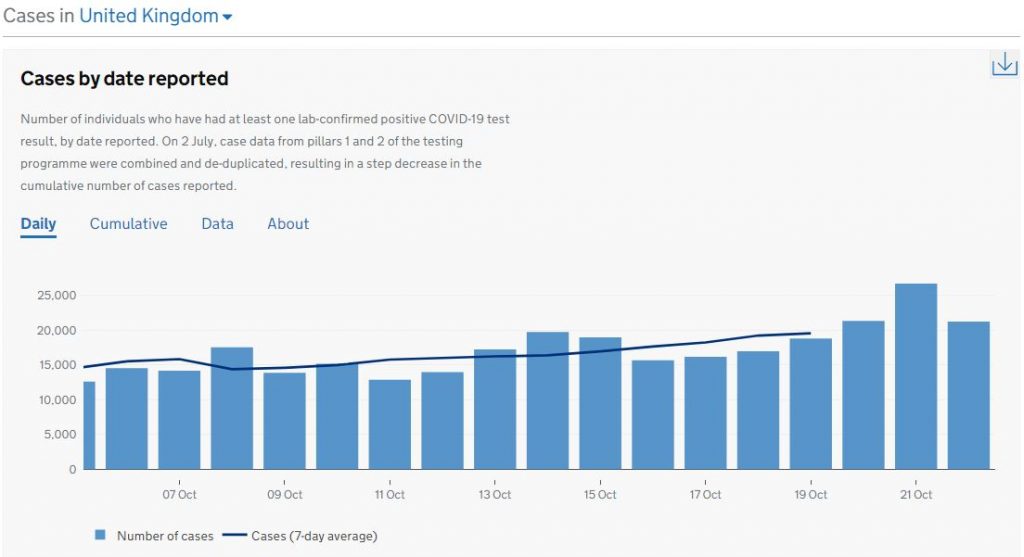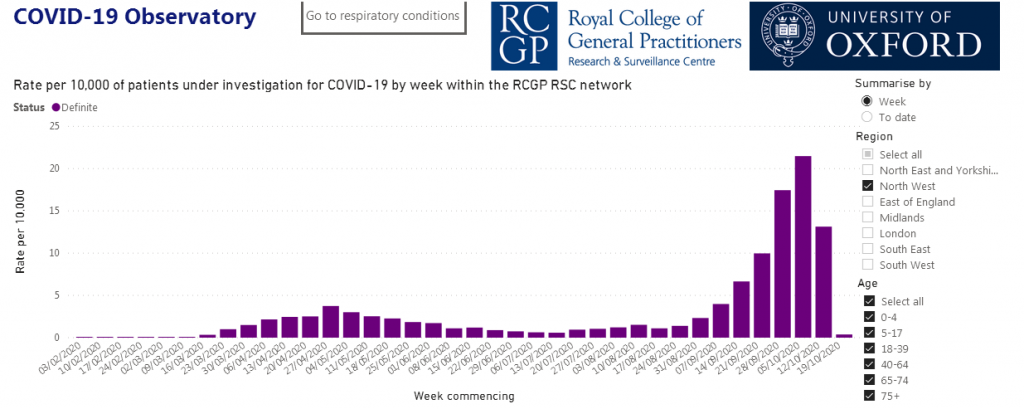Case Counting: Government Quietly Starts Double Counting Positives
Fri 10:47 am +01:00, 23 Oct 2020
“Case” numbers are all over the place at the moment. After hitting a high on Wednesday of 26,688 reported, they were back down to 21,242 yesterday. By specimen date there still appears to be no overall growing trend since October 12th, except for a bizarre tower on October 19th. As ever with “cases”, what these positive test results actually mean and how they relate to clinical cases of the disease COVID-19 is difficult to unravel.
One issue is whether “cases” now include repeat positive tests for the same individual, conducted for example as they await the all-clear. Previously they did not, but it was revealed this week that as of Thursday October 15th the Government has begun to include duplicates as long as they are from different survey weeks. This means that each person who tests positive and is then tested again each week will continue to add new “cases” to the counter for as long as the test (at what sensitivity they don’t say) continues to find some virus fragments to trigger it. Here’s the relevant part of the revised methodology statement.
People tested and people testing positive
For both pillars 1 and 2, data for England is provided by the NHS and PHE and the number of confirmed cases are collated to give the total number of confirmed cases over the reporting period. More details about the data sources and methodology for pillar 1 and pillar 2 can be found in the section Coronavirus (COVID-19) testing in the UK.
From October 15th, the methodology for people tested and people testing positive has changed.
Previously, the number of people newly tested and newly testing positive was reported, where the figures were de-duplicated over the entirety of the pandemic so an individual would only appear once. This meant someone tested in March and again in September would only be counted in the March counts. This was progressively becoming less meaningful the longer the duration of the pandemic and meant that it was not appropriate to calculate a positivity rate from this data.
Figures are now reported as people tested and people testing positive at least once in the reporting week. People tested or testing positive are only counted once over the 7-day reporting period (Thursday to Wednesday), with a positive test being prioritised over a negative test. A person can be counted within more than one 7-day reporting period. If someone was tested more than once in different reporting weeks, they would be included in the count for all reporting weeks they were tested in.
For example, if a person was tested on Thursday and Friday of the same week, they would only be counted once in the reporting week. However, if someone was tested on Tuesday and Friday of the same week, that individual would be counted in 2 reporting periods, as the 2 tests fall into different 7-day reporting periods. If a person is tested under both pillar 1 and pillar 2 in the same reporting week, then only the pillar they were first tested under is counted, unless they were tested in both pillars on the same day, in which case, they are counted under pillar 2.
Is this what lies behind the increase in week beginning October 15th? It’s unclear whether this change will affect daily case data, as reported on the Government’s coronavirus dashboard, or just the weekly statistics released by NHS Test and Trace. The way the Government introduced this major change without proper announcement or explanation is very poor and doesn’t exactly help us understand the course of the epidemic. As far as we are aware, this is the third methodological change the Government has made when it comes to calculating cases and the positivity rate since July 2nd.
To be fair to NHS Test and Trace, this change may be intended to eliminate the problem in calculating the positivity rate that Dr Clare Craig spotted in tab 5 of the dataset in the press release that accompanied Chris Whitty and Patrick Vallance’s presentation on September 30th. A note in tab 5 stated: “The number of people tested in a given week will exclude some people who have been tested in a previous week, so may not be an accurate denominator to use. For example, someone testing negative for the first time in week 1 will be counted in the ‘people tested’ figure for that week. If that same person tests negative again in week 4, they will not be counted in the ‘people tested’ figure for week 4.” As Clare pointed out, if NHS Test and Trace wasn’t including repeat negative testers in the weekly test results – people who’ve tested negative before – that meant the denominator was being artificially deflated and the positivity rate artificially inflated. So what this new change may mean is that repeat testers who’ve tested negative in the previous week are now included in the denominator when it comes to calculating the positivity rate. But when NHS Test and Trace made this change it also decided to include repeat testers who’ve tested positive in the previous week when it comes to calculating “cases”, thereby increasing the number of positive “cases” in the weekly releases. We’ve asked Clare about this and she confirmed this reading. As she said, the most honest way of reporting this would be to only include first positives in the daily and weekly testing data and to keep all the negatives in the denominator when calculating the positivity rate.
Meanwhile, the latest update from the Royal College of General Practitioners shows that patients under investigation for COVID-19 dropped considerably in the North West in the week ending October 18th. This is yet another indication that the autumn epidemic in and around Manchester peaked well ahead of its Tier 3 restrictions coming into effect.

Needless to say, these are not the figures of an epidemic “increasing exponentially ” and in need of authoritarian intervention.
Stop Press: Check out this Facebook video by Luke Pompey. He gets a Covid test in the post, breaks the swab stick in half without taking any swabs, posts it back to the NHS then gets a positive result in the mail a few days later.
By
https://lockdownsceptics.org/


